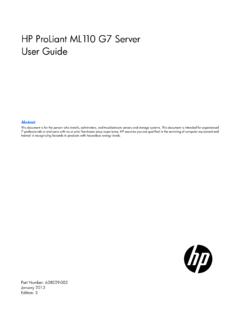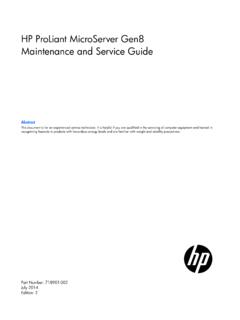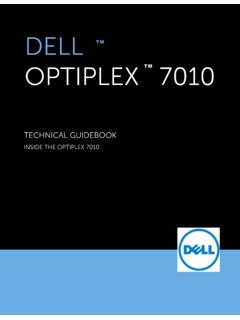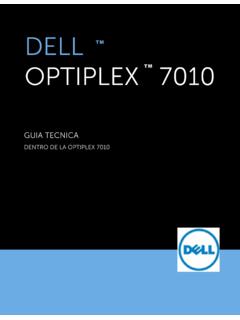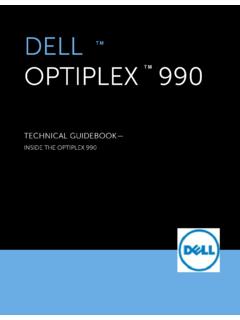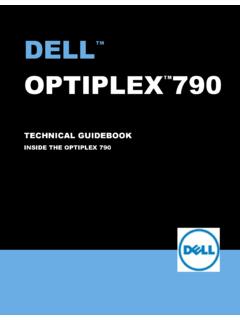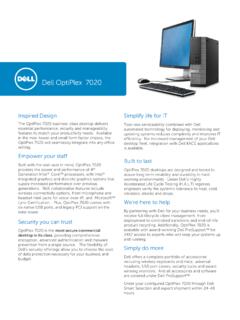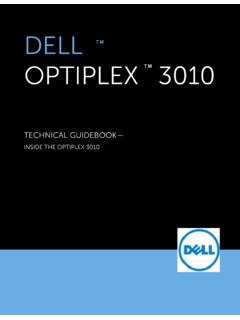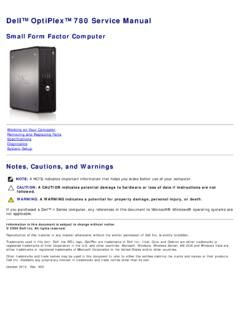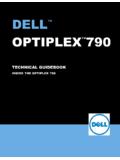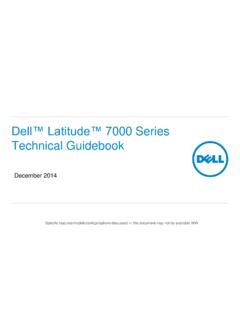Transcription of Dell OptiPlex 760 Service Manual - GfK Etilize
1 dell OptiPlex 760 Service Manual Mini Tower Computer Desktop Computer Small Form Factor Computer Ultra Small Form Factor Computer Back to Contents Page Advanced Features dell OptiPlex 760 Service Manual LegacySelect Technology Control Manageability Physical Security Trusted Platform Module (TPM) Security Management Software Computer Tracking Software About Smart Cards and Fingerprint Readers Hyperthreading and Multi-Core Technology Power Management for Windows XP and Windows Vista LegacySelect Technology Control LegacySelect technology control offers legacy-full, legacy-reduced, or legacy-free solutions based on common platforms, hard drive images, and help desk procedures. Control is provided to the administrator through system setup, dell OpenManage IT Assistant, or dell custom-factory integration.
2 LegacySelect allows administrators to electronically activate or deactivate connectors and media devices that include serial and USB connectors, a parallel connector, a floppy drive, PCI slots, and a PS/2 mouse. Connectors and media devices that are deactivated make resources available. You must restart the computer to effect the changes. Manageability DASH DASH (Desktop and mobile Architecture for System Hardware) is a Desktop Management Task Force (DMTF) management initiative that standardizes the manageability interfaces for mobile and desktop hardware. The focus of the DASH architecture is to enable the remote management of desktop and mobile computing resources in a standard manner that is independent of operating state. Your computer supports early versions of the DASH initiative including the following management profiles: l Base Desktop Mobile l Power State Management l Boot Control l CPU l System Memory l Fan l Power Supply l Sensor l Physical Asset l Software Inventory Active Management Technology Intel Active Management Technology (iAMT) provides secure systems management capabilities that reduce IT costs and allow better discovery, healing, and protection of networked computing assets.
3 With iAMT, computers can be managed regardless of whether the computer is on, off, or the operating system is hung. Key benefits of iAMT are: l Reduced desk-side visits l Automation of more management functionality through enablement of systems management console software l Improved security NOTE: If you have chosen to use "None" (no manageability) or ASF, you will be unable to take advantage of DASH features and profiles. NOTE: iAMT can be configured using dell Client Manager (DCM) or later. For complete information on how to configure iAMT, see the dell Client Manager (or later) documentation on \openmanage. For more information about dell 's iAMT implementation, see the Client Systems Management Administrator's Guide available on the dell Support website at Features Basic Functionality l Ability to discover, track, and inventory assets in the presence or absence of the operating systems.
4 The computer must have the power cable connected and must be connected to the network. l Ability to power on and power off the computer remotely, whatever the state of the operating system. Advanced Functionality l Ability to do remote issues remediation (1-to-1) via text-based console redirection (Serial-over-LAN) and IDE redirection. l Hardened security via agent presence (enables detection of removed agents) and network access control (Circuit breaker) and software version control Your computer aids in troubleshooting iAMT by providing the following iAMT related error messages: Out of Band Management The term "out of band" refers to the ability to manage the computer in the absence of an operating system or with the operating system in an unusable state, or with the computer powered off.
5 The only requirement for managing such a computer is for AMT capability to be enabled and a network cable plugged into the integrated network adapter. Accessing iAMT setup Intel's Management Engine BIOS Extension (MEBx) interface controls the iAMT features and setup options for your computer. MEBx is used to: l Turn on or off iAMT l Set iAMT modes l Set iAMT configuration modes To view the MEBx setup screen, press <Ctrl> <p> during the boot process of your computer when you turn it on. Your default MEBx password is admin. Turning Off iAMT iAMT is enabled in the Management Engine (ME) firmware by default. However, you may choose to turn off the iAMT feature. To turn off iAMT: <Ctrl-P> to enter the MEBx setup and enter your password. Intel ME Configuration Intel ME Features Control Manageability Feature Selection None.
6 Return to Previous Menu twice. Changes are applied and the computer reboots. USB Provisioning iAMT can be provisioned using a USB key and dell Client Manager. The USB key must: NOTE: Additional management software and purchasing options are required for some of the following features. Error Message Description SERVICE_MODE jumper: The Service mode jumper is installed Do not populate the SERVICE_MODE jumper. AMT will not function properly. Only manufacturing uses this jumper. MEMORY: Unsupported memory configuration. Populate DIMM1. Unable to launch ME. AMT functionality is broken when DIMM1 is not populated. NOTE: Power is supplied to the DIMMs even when the computer is turned off. NOTE: To make configuration setting changes, the default MEBx password must be Be formatted using the FAT16 file system with no system files l Contain only the file To provision AMT using a USB key, plug the USB key into a USB port prior to boot.
7 During POST, the BIOS displays a message stating that the computer is being provisioned. Alert Standard Format Alert Standard Format (ASF) is a DMTF management standard that specifies "pre-operating system" or "operating system-absent" alerting techniques. The standard is designed to generate an alert on potential security and fault conditions when the operating system is in a sleep mode or the computer is turned off. ASF is designed to supersede previous operating-system-absent alerting technologies. Your computer supports the following ASF version and alerts and remote capabilities: ASF allows Remote Management and Control Protocol (RMCP) messages to be exchanged between a remote management console and a client computer that is in a "pre-operating system" or "operating system-absent" state.
8 RMCP messages can be sent to instruct a client computer to start up, shut down, or restart. For more information about dell 's ASF implementation, see the ASF User's Guide and the ASF Administrator's Guide, which are available on the dell Support website at dell OpenManage Applications You can manage your computer via IT Assistant and dell OpenManage Client Instrumentation (OMCI). IT Assistant configures, manages, and monitors computers and other devices on a corporate network. IT Assistant manages assets, configurations, events (alerts), and security for computers equipped with industry-standard management software. It supports instrumentation that conforms to SNMP and CIM industry standards. For information on IT Assistant, see the dell OpenManage IT Assistant User's Guide available on the dell Support website at dell OpenManage Client Instrumentation is software that enables remote management programs such as IT Assistant to do the following: l Access information about your computer, such as how many processors it has and what operating system it is running.
9 L Monitor the status of your computer, such as listening for thermal alerts from temperature probes or hard drive failure alerts from storage devices. A computer that has dell OpenManage Client Instrumentation set up on a network that uses IT Assistant is a managed computer. For information about dell OpenManage Client Instrumentation, see the dell OpenManage Client Instrumentation User's Guide available on the dell Support website at dell Client Manager (DCM) dell Client Manager (DCM) Console The dell Client Manager (DCM) console allows you to configure, manage, and monitor dell computers on a corporate network via a simple GUI interface. Through the DCM console you can manage assets, configurations, events (alerts), status, and security for computers equipped with industry-standard management software.
10 For information about standards supported by DCM, see For information about the DCM console, see or the dell Support website at The DCM console also allows you to: NOTE: The key should not be bootable. Alert Description Chassis: Chassis Intrusion Physical Security Violation/Chassis Intrusion Physical Security Violation Event Cleared The computer chassis with the chassis intrusion feature (optional on some computers) installed and enabled has been opened or the chassis intrusion alert has been cleared. CPU: Emergency Shutdown Event The processor temperature is too hot and the power supply has shut down. Cooling Device: Generic Critical Fan Failure/Generic Critical Fan Failure Cleared The fan speed (rpm) is out of limits or the fan speed (rpm) problem has been resolved. Temperature: Generic Critical Temperature Problem/Generic Critical Temperature Problem Cleared The computer temperature is out of limits or the computer temperature problem has been resolved.







